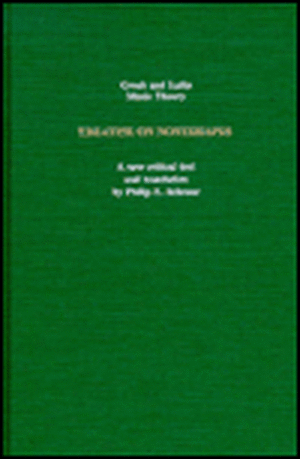The Tractatus Figurarum (A treatise on noteshapes): Subtilitas in the Notation of the Late Fourteenth Century: Greek and Latin Music Theory
Autor Philip E. Schreuren Limba Engleză Hardback – 31 oct 1989
Notational complexity, or subtilitas, was engendered in the late fourteenth century by a thorough probing of all the rhythmic possibilities within the accepted mensurations. As French and Italian notational practices began to diverge at the beginning of the Ars nova, composers invented new rhythmic symbols—figurae—as their innovations required, and this resulted in a variety of notations that were as confusing to the musician of the day as they are to the modern scholar.
In the third quarter of the fourteenth century, a notational system combining elements of the French and Italian systems was put forth in the Tractatus figurarum. This system proposed a standard of set of figurae for simultaneous combinations of any two of the four prolations of the French mensural system.
Edmond Coussemaker’s 1869 edition of the Tractatus figurarum, which attributes the treatise to Philippus de Caserta, was based on his knowledge of only four of the fourteen surviving manuscripts. A critical study of all the sources, including the important Newberry Library manuscript, leads to a corrected version of the text and allows the entire system to be resurrected. The critical edition is joined with fully annotated translation on facing pages. An Introduction discusses the authorship and theory of the treatise, as well as placing it within the context of the music theory of the fourteenth century. Full descriptions of all the manuscript sources and four full-color plates of the Newberry Library manuscript are included.
The system of the Tractatus figurarum was beautifully creative, but it did not meet with success. Nevertheless, the treatise proves itself invaluable to the study of the Ars subtilior in revealing certain basic notational principles that may be applied to surviving musical compositions, illuminating the notational subtleties in which the music delighted.
Edmond Coussemaker’s 1869 edition of the Tractatus figurarum, which attributes the treatise to Philippus de Caserta, was based on his knowledge of only four of the fourteen surviving manuscripts. A critical study of all the sources, including the important Newberry Library manuscript, leads to a corrected version of the text and allows the entire system to be resurrected. The critical edition is joined with fully annotated translation on facing pages. An Introduction discusses the authorship and theory of the treatise, as well as placing it within the context of the music theory of the fourteenth century. Full descriptions of all the manuscript sources and four full-color plates of the Newberry Library manuscript are included.
The system of the Tractatus figurarum was beautifully creative, but it did not meet with success. Nevertheless, the treatise proves itself invaluable to the study of the Ars subtilior in revealing certain basic notational principles that may be applied to surviving musical compositions, illuminating the notational subtleties in which the music delighted.
Preț: 385.92 lei
Nou
Puncte Express: 579
Preț estimativ în valută:
73.86€ • 76.52$ • 61.64£
73.86€ • 76.52$ • 61.64£
Cartea se retipărește
Doresc să fiu notificat când acest titlu va fi disponibil:
Se trimite...
Preluare comenzi: 021 569.72.76
Specificații
ISBN-13: 9780803242036
ISBN-10: 0803242034
Pagini: 122
Ilustrații: Illus
Dimensiuni: 140 x 216 mm
Greutate: 0.37 kg
Editura: UNP - Nebraska
Colecția University of Nebraska Press
Seria Greek and Latin Music Theory
ISBN-10: 0803242034
Pagini: 122
Ilustrații: Illus
Dimensiuni: 140 x 216 mm
Greutate: 0.37 kg
Editura: UNP - Nebraska
Colecția University of Nebraska Press
Seria Greek and Latin Music Theory
Notă biografică
Philip E. Schreur is the Music Librarian at the University of California, Davis.




